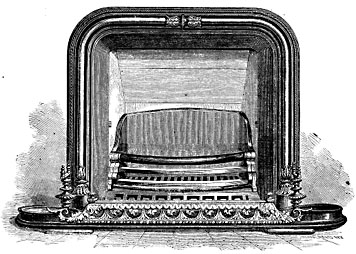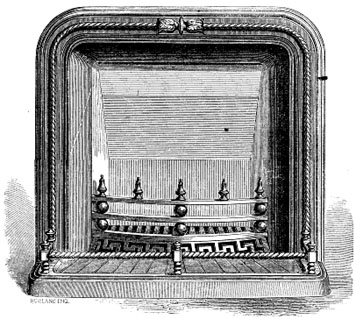
THERE is a constant tendency toward the revival of old fashions, old styles, and old methods. These are improved, it is true, just as the crinoline of modern belle is a very different affair from the hoops which encased the fair ones of the court of Queen Anne. When our forefathers landed on these shores, they found that the grates and fire-places of Britain were utterly inadequate to maintain a proper degree of warmth during our cold winters. So the grate and the fire-place were abandoned, and stoves for burning wood and coal took their place. Today, we are returning to the fashion of a former period and the grate is again quietly resuming its place in our houses, though perhaps it is no longer depended upon for the supply of the full amount of necessary warmth, being aided in this respect by the furnace and the steam boiler. Impressed with the advantages which may be derived from the use of well constructed grates, both in the matter of ventilation and home-like cheerfulness, we made a visit recently to the well-known establishment of William H. Jackson & Co., of this city, and examined not only the products of their skill but their system of producing them. It is of the former, however, that we propose chiefly to speak in this article. The engravings on this and the opposite page, show the beautiful character of the designs which these gentlemen have introduced, and the character of the workmanship comes fully up to the delicacy and chasteness of the artistic conception. The superlative polish of the steel is quite equal to that of any imported work, and the contrast between the pale brilliancy of the steel and German silver and the richness of the heavily gilt ornaments is well arranged and very effective. Our readers will be surprised to learn the extent to which our citizens are carrying the luxury of modern refinement into their dwellings. For one house now in process of erection in Cincinnati, Messrs. Jackson &
Co. have an order for eight grates, the aggregate cost of which is over two thousand dollars! Among the ingenious novelties which have been recently adapted to grates is the grate gas-burner. This consists of a series of terra cotta tubes, fashioned exteriorly into the shape of rough sticks of wood, which are supported apparently on old-fashioned andirons. These tubes are pierced with numerous holes, through which the gas issues when it is turned on. The series of flickering flames thus produced have all the appearance of a veritable old – fashioned wood-fire; and when the tubes and the soapstone sides of the grate become heated, a good deal of warmth is given out. We do not regard this as by any means an economical method of consuming gas for heating purposes; but it produces a very cheerful, cozy appearance in a room, and adds greatly to the thorough ventilation of the apartment in which it is placed. An ordinary grate consumes about fifty cubic feet of gas per hour, which makes the cost about fifteen cents for the same time. Fifteen cents? worth of coal would undoubtedly produce a greater effect, but certainly not a more pleasant one.

